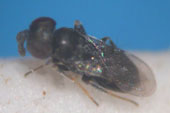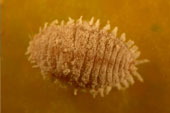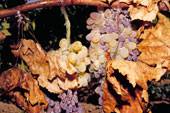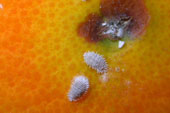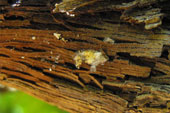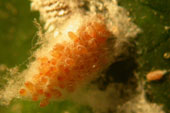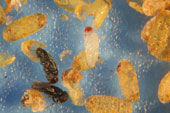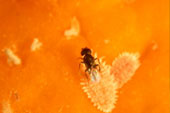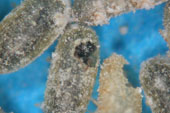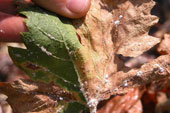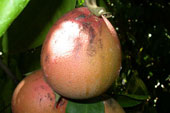 |
| Home |
| Products |
| PER-MX® |
| RAP-TX® |
| TRI-MX® |
| Citrus Pests & diseases PHoto Gallery |
| Packaging / Shipping |
| Contact Us |
| Enquiries |
 |
| Perminutus Parasites |
|
PER-MX - (Coccidoxenoides perminutus)
Target organisms Advantages of Perminutus wasps/biological control Best time to use? Biology of the Perminutus parasite Questions and answers: Summary Perminutus are small parasitic wasps which are reared in climate controlled rooms at an insect breeding facility, the Vital Bugs Insectary, close to Tzaneen. We rear the Perminutus wasps on mealybugs, which in turn are reared on butternut squash. Perminutus is effective against immature mealybugs of approximately 1 – 3 mm in length, and can track down mealybugs in vineyards, orchards and nurseries through sight and smell. Adult mealybug are also vulnerable to Perminutus attack, by the process of mutilation. Mutilation occurs when Perminutus bite or suck the mealybug as a food source. Perminutus poses no threat to none-target species, even if the supply of host insects is in short supply. Perminutus wasps are minute and cannot ‘sting’ humans or animals like honey bees or wasps do. Target organisms:
• Citrus mealybug (Planococcus citri) • Citrophilous mealybug (Pseudococcus calceolariae) Target crops:
• Citrus: Navel oranges, grapefruit and Valencia oranges (not generally used on Citrus in the Western Cape due to the presence of a complex of mealybug species, some of which are not attacked by Perminutus) • Ornamental plants • Other fruit e.g. persimmon and figs Advantages of Perminutus wasps / biological control:
• They contribute to resistance management – mealybugs are not able to develop resistance against parasite attack • No side-effects on other beneficial insects (thus no repercussion pests) • No soil or water pollution • Quick and easy to use – no tractors or spray equipment needed • They are safe. No threat to nature, humans or other animals Timing the release The sooner releases are made, the more effective is the control achieved. It is cheaper and easier to prevent a build-up of mealybug than to bring an outbreak under control. The best time to start a release program is during spring/early summer, when the first mealybug eggs and crawlers are seen in the field. Alternatively, pheromone traps can be used to determine the flight peaks of male mealybugs, and parasite releases can then be scheduled accordingly. It is recommended that parasite releases commence two to three weeks after the first male mealybug flight peak. How to order the wasps: A release programme is compiled by the advisor / consultant based on the specific needs and requirements of the customer. This program includes the number of parasites needed and the ideal release periods required to achieve effective pest control. Factors that can influence the decision making process are, the mealybug infestation rate during the previous season, the time of year, other control measures applied during the winter and the objective of the releases. The expectations of the client also play a critical role in the final decision making. A typical release programme * normally consists of two to three releases of 10 000 - 20 000 Perminutus per hectare, spaced three to six weeks apart. Placed orders will be confirmed within a week by our production department. * In some instances (with moderate to high mealybug infestations) we recommend the use of mealybug predators. More information on their use and availability can be obtained from our offices or from our sales representatives in the field. Packaging of the parasites Parasites are packaged in polystyrene cool boxes, with ice-bricks, in batches of 3 000 parasitised pupae per individual container. The number of containers dispatched will correspond to the number of parasites ordered e.g. if 150 000 Perminutus are ordered, it will be packaged in 50 release-containers. Dispatching the parasites Customers are notified via e-mail or SMS once their parasites have been dispatched. Delivery is expected within a day or two. Parcels that fail to arrive within two days of dispatch should be followed up with the relevant courier service and / or reported to us. On arrival of the parasites Upon arrival it is recommended that the ice-bricks be replaced in order to maintain the cold chain. Specific instructions on the release of parasites in the field / grapevine will accompany the first consignment. Please follow these guidelines carefully to ensure best results. If moderate weather conditions prevail, parasites can be released immediately, preferably within 24 hours of receipt. The best time of day for release is before 11:30 in the morning or after 15:30 in the afternoon. Should extreme climatic conditions prevail, e.g. heavy downpours or heat waves, parasite development can be slowed by replacing the ice bricks in the cool box every day for up to three consecutive days. A longer delay is not advisable since the quality of the parasites may start declining. Never store the parasites in a refrigerator since the low temperature could be lethal. Biology and lifecycle of the Perminutus parasite Perminutus is a very small, black parasitic wasp belonging to the family Encyrtidae. Using a 10x magnifying glass they can often be seen moving amongst mealybug colonies. They reproduce parthenogenically, in other words, females can reproduce without mating. Perminutus lays its eggs exclusively on immature 1st and 2nd stage mealybugs. The female lays her egg inside the mealybug, and the Perminutus larva hatches inside the host within a few days. The wasp larvae develop within three to five weeks inside the mealybug’s body, without killing it. By the time the Perminutus larva forms a pupae, the mealybug has been totally devoured, and only an empty shell called a mummy remains. The adult Perminutus wasp escapes from the mealybug cadaver by creating an emergence hole, and disperses through the orchard or vineyard, seeking to parasitise other mealybugs. With adequate nutrition the wasp is able to parasitize between 20 and 100 mealybugs in its lifetime. Adult Perminutus not only destroys mealybugs by parasitizing them, they also feed on mealybugs by piercing the host with their ovipositor and consuming the body fluid. The process is known as mutilation and is often detectable by the presence of distinct black spots on mealybugs’ bodies. Questions and answers: Do the parasites survive in nature? What about insecticides / fungicide sprays? It is very hot and dry here in summer. Will the parasites work here too? If there’s a heavy mealybug infestation, can the parasites become a ‘pest’ themselves later on? Alternatively, what will happen if their food runs out… will they start attacking something else? How well do the parasites work? What can I do to assist the parasites reach maximum efficacy? Do the parasites survive in nature? The parasites in our rearing facility were collected locally from various sites in South Africa. They occur naturally in the region, and are well-adapted to South African climatic conditions. The effect of releases usually only become apparent towards the end of the production season, and initially it may seem that the parasites are not effective at all. That is because parasitised mealybugs tend to ‘hide’ once they’re parasitised, and often fall to the ground. What about insecticides / fungicide sprays? Some crops cultivated in South Africa e.g. citrus, are vulnerable to an array of pests early in the season. These pests often require chemical intervention early in the season. As growers make the change to more environmentally friendly pest control methods non-target pest species which were previously under chemical control, can make a resurgence. However this is usually short lived since the pest species’ natural enemies gradually re-establish in the agri-ecosystem. Since not all pests have biocontrol agents available, the responsible use of insecticides will likely remain an integral component of good agricultural practice. To maximise the efficacy of the parasites and predators, it is advisable to schedule the releases around the chemical applications. Parasites can often be released two or three weeks after a pesticide application. If harsh or broad spectrum pesticides with a long residual action are to be applied the release of parasites or predators should not be scheduled within two weeks of application. Our qualified entomologists / sales consultants are well-trained and ready to give you professional advice in this regard. It is very hot and dry here in summer. Will the parasites work here too? Independent trials involving Perminutus releases were conducted in a wide range of citrus and grapevine producing areas, with excellent results. We believe that the parasites are suitable for use in the whole of South Africa. If in doubt, we recommend starting with small scale releases of one to three hectare and gradually increase the area treated once confidence in, and experience with the use of parasites is gained. If there’s a heavy mealybug infestation, can the parasites become a ‘pest’ themselves later on? Alternatively, what will happen if their food runs out… will they start attacking something else? The answer in both cases is “No”. The parasites are host specific and attack only certain types of mealybug commonly found on citrus and vines. If they experience a shortage of food, the wasps will disperse in search of mealybug. They cannot survive on an alternative host. How well do the parasites work? The release of parasites is a form of biological control and is never a quick solution. Control takes place gradually but relentlessly, and often it is just as, if not more effective, than standard chemical applications. Many a satisfied customer can bear testimony to the effectiveness of Perminutus parasites. What can I do to assist the parasites reach maximum efficacy? 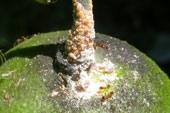 Mealybug will often increase when ants are present, because ants fend off natural enemies. Note the black sooty mold growth on the fruit.
• Ensure good supervision of the contents of the parcel containing the wasps from the time the parcel is received until the parasites are released in the field. Only responsible persons should be entrusted with transporting and releasing the parasites on the farm, taking care to follow enclosed release guidelines meticulously. • Intercropping with cover crops such as Rhodes grass, can supply nectar and pollen to beneficial insects and so help sustain higher populations of natural enemies in the release area. However, ensure that the grass does not grow into the trees or vineyards and provide access routes for ants. • Conduct weekly pest monitoring during spring and summer, in order to identify mealybug hotspots timeously and apply suitable corrective measures when needed. |

© Copyright Vital Bugs 2008 | All Rights Reserved
